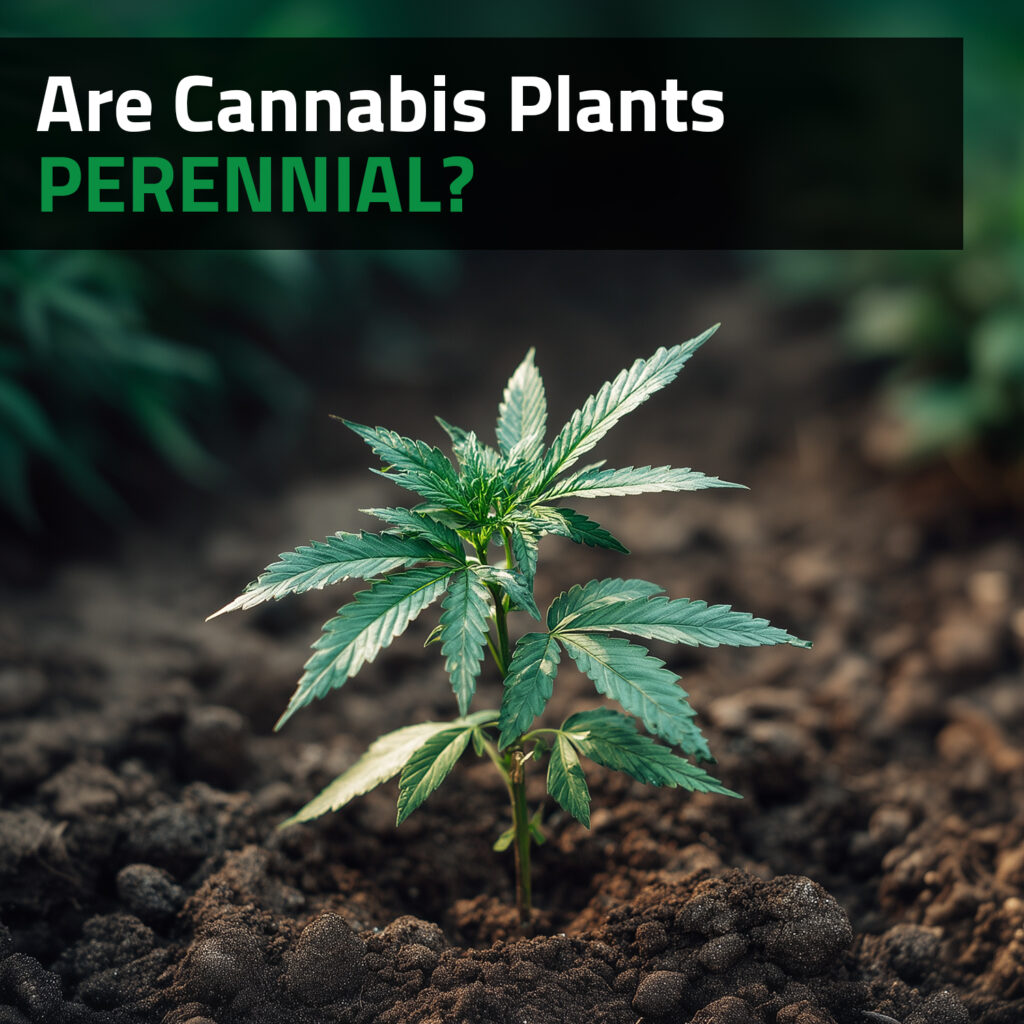Cannabis is often surrounded by myths and confusion – one prominent misconception is whether it is an annual or perennial plant. In gardening and botany, these terms carry specific meanings, and cannabis does not fit the definition of a perennial in most situations. This guide dives deep into plant life cycles, explains where this misconception comes from, and explores techniques used by cannabis growers to maintain plants year after year.
Annual Vs. Perennial: Botanical Definitions
- Annual plants complete their life cycles – from seed to flower to seed – within a single growing season (typically a year or less), after which they die.
- Perennial plants live for over two years, often regenerating new growth each spring from longevous roots or woody stems.
- Cannabis is fundamentally an annual plant – Cannabis, including industrial hemp and drug-type plants, grows from seed, flowers, sets seed, and dies – all in one season, ranging from four to ten months. During winter, it cannot regrow from the same roots like real perennials. Seeds may fall to the ground and sprout next year, but the original plant itself does not return.
This behavior is due to the cannabis plant’s natural adaptation to seasonal changes. In temperate climates, shorter daylight hours trigger flowering, and colder weather leads to death after reproduction. In other words, the plant has a built-in biological clock that aligns with the cycle of the seasons.
Why Cannabis Is Not A Perennial
- Cannabis completes its life cycle in a year: Once a cannabis plant flowers, it begins senescence, ultimately dying post-harvest
- No regrowth from the same roots: Unlike perennials, cannabis does not overwinter and return the following year. Even in mild climates, while some root tissue may survive short winters, the plant typically cannot regrow new stems and flowers without human intervention .
- Any seeming continuation is self-seeding: Volunteer seedlings emerging from dropped seeds may give the illusion of the same plant returning, but genetically these are new plants – not the same parent.
Contrasting Cannabis With True Perennials
| Feature | Cannabis (annual) | True perennials |
| Life span | 4–10 months | 2+ years, sometimes decades |
| Regrowth | No after flowering | Yes, from roots/stems |
| Seed dependency | Each season from seed | Can regenerate from rootstock |
| Lifecycle control | Light-driven flowering | Seasonal cues inherent |
Why People Think Cannabis Can Be Perennial
Although cannabis is an annual plant, there are some reasons why many confuse them with being perennial.
- Indoor vegging & cloning: Keeping cannabis in a vegetative state for mother plants can extend lifespan indoors indefinitely – but this relies on preventing flowering through constant light, not true perennial growth.
- Self-seeding in warm climates: In regions with mild winters, dropped seeds can sprout in spring, giving the appearance of perennial regrowth – but they are new plants from seed .
- Re-vegetation: Some growers force flowering plants back into veggable state (reveg), enabling a second harvest – but this stresses the plant and reduces yield; it is still essentially prolonging a single annual’s life .
Are Perennial Cannabis Varieties Possible?
Some theorise that ancestral cannabis populations in tropical or subtropical climates may have behaved more like perennials, with cyclical growth patterns linked to seasonal conditions .
However, no domesticated strain today exhibits true perennial traits.
Selective breeding or tissue culture could theoretically produce repeat-flowering or perennial-like cannabis, but none exist commercially. Breeders continue to explore longevity and repeated harvest strategies .
Grower Strategies To Simulate Perennial Cultivation
Though cannabis is an annual, growers employ methods to achieve continuous yields:
- Cloning mother plants: Provide constant light to mother plants and periodically take cuttings to harvest clones – this bypasses seed cycles but essentially keeps an annual plant in vegetative phase indefinitely.
- Re-vegetation cycle: After primary harvest, allow a plant to re-enter vegetative growth via adjusted light cycles. While possible, quality and yield decline, and stress may induce hermaphroditism.
- Autumn Self-seeders: Leaving seeds to germinate in situ can yield volunteer plants next spring that produce outdoors in sync with the seasons.
Lifecycle Summary: From Seed To Seed
- Germination & seedling stage: 1–3 weeks
- Vegetative growth: 2–16 weeks
- Flowering: 6–12 weeks
- Senescence: Post-harvest die-off
Once flowering concludes, the lifecycle ends. Seeds that drop and sprout next year represent a new cycle – not perennial continuation.
Climate Change Complications
Milder winters and warming climates can cause cannabis to misjudge seasonality – remaining lightly alive instead of dying back fully, which leads to unpredictable blooming or failure to flower properly .
Benefits Of Perennial Cultivation (Controlled Environment)
Although it is rare, maintaining cannabis as a long-living plant has distinct advantages, especially in commercial or hobby growing settings:
- Genetic preservation: Keep prized phenotypes alive without needing to rely on seeds or fresh clones.
- Sustainability: Fewer seeds or new clones needed, reducing waste.
- Rapid harvest turnaround: With a re-vegged or mother plant, growers can skip the germination and seedling stages.
Limitations Of Perennial Cannabis Growing
Despite the appeal, growing cannabis as a perennial is not without drawbacks:
- Decreased vigour over time: Re-vegged plants may become less productive or prone to stress.
- Resource intensive: Indoor cultivation demands energy, light, and nutrients to sustain year-round growth.
- Space requirements: Maintaining mother plants long-term can be impractical for small-scale growers.
What About Autoflowers?
Autoflowering cannabis varieties are even more rigid in their life cycle. These plants begin flowering based on age rather than light cycles and typically finish within 8–12 weeks. They are strictly annual and not viable for re-vegging or perennial growing techniques. Once harvested, an autoflower plant will not regrow.
Landrace Strains And Natural Longevity
Some landrace strains – particularly equatorial sativas – may not follow the rigid timelines of hybridised strains. These plants can grow for extended periods due to environmental stability, potentially mimicking a semi-perennial nature. In their native regions, with consistent light and warmth, such plants may grow much longer before flowering or may be harvested multiple times.
While cannabis is technically an annual plant, it has the potential to behave like a perennial under the right conditions. Whether through regeneration, controlled lighting, or maintaining mother plants, growers have options to extend a plant’s life well beyond a single season.
Understanding the plant’s biology and life cycle helps cultivators make informed decisions, whether they are growing for commercial, medical, or personal use. So while your cannabis plant may not live forever, it does not always have to be a one-season wonder.
Recommended products
-
Zootly CBD Fudge (20mg)
R40.00 -
DAVINCI IQ-C Vaporizer
R3,950.00 -
BLK Black Mamba Dry Herb Vaporizer
R850.00 -
PUFFCO Peak Pro Vaporizer
R7,500.00










